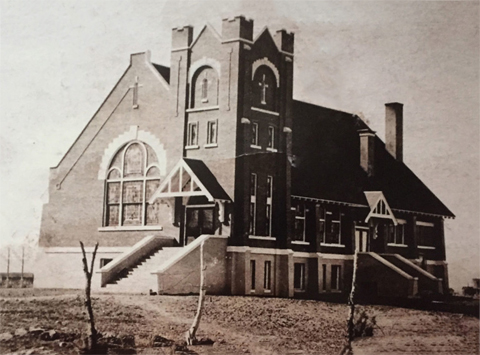I was born in Weston, Idaho, in 1886–the 13th of February. My father was Jim Bell, my mother was Nellie Schvaneveldt Bell. I was named Mary Jane after my father’s sister.
I was married in December, so I was still 17. (December 22, 1903.) My husband was Albert Dawson. We lived in the same town–were in the same crowd–got to go to dances, you know. I guess that’s where I met him, at a dance, I can’t remember.
When we had three or four children, we moved up to Bannock Valley to take up a farm. We were there four years, long enough to prove up on that homestead. This was southwest of Pocatello, about 35 miles; and about the same distance from American Falls. We were straight south of American Falls and that’s where we did our trading, mostly, because the roads were kept open more through that canyon. This was a dry farm. All the water we had there was from windmills. Now, all that property is owned by just one man, and he’s wealthy. He kept buying up little places.
Question: What kind of a home did you have?
Well now, I’ll tell you. We started out in a dugout. Have you ever heard of a dugout? It was about 10×12, I imagine. And in that dugout we had our stove, our bedsteads, table, everything we had to use, chairs and such things. We even used to hold Sunday school in those dugouts. There were five of us who had dugouts, five I think–five of the Dawsons. We all went out there together. Let’s see, one of the families was Emma Dawson–my husband’s sister–she married Bert Heusser. We’d change off holding Sunday school in the different dugouts, and boy, when you think back, we had some good Sunday schools. Everybody sat on the bed that could get in there, they’d sit on the table, anywhere. Our chairs were nail kegs. We’d go over to some of the big stores in Pocatello or American Falls and get the kegs. We’d take good care of them
Question: How did you work your stove?
The stove? Oh, it was a wood stove, you know. The pipe just went up through. When it rained we had to take care of all those things, put cans around the pipe, get the water before it put your fire out. If you didn’t have cans or buckets you’d have to put your big mop rag around to soak it up and then wring it out in the wash basin. We wouldn’t put water on the floor–we were afraid the baby would catch cold.
The dugout was like a cellar, you might say, with two rows of logs on top to shore it up. Then they put slats over the logs, then willows and straw, then dirt. In the winter the snow would come so hard and fierce. We had clothes lines, some of us, and it would cover the lines up completely. And it would cover the dugouts so you wouldn’t know anything was there, just mounds of the snow.
I remember we dug steps out–of course it covered up the entrance too. We always kept the boiler and the tub down in the dugout and when those big snow storms came we’d open that door, which was a quilt at first, or an old blanket that was tacked up, so we’d open that up and take the shovel, which we had to keep inside, and we’d shovel this snow into the boiler and melt it. We’d keep filling it up, to get rid of all the snow. We dug steps up there until–I think it was 14 steps–to get out of the dugout and up over the snow.
We had a cow and they had to put all but one horse out to John Lusk’s place to winter them. Lusk was from Malad, his folks lived in Malad–that is, they were out there before we were and had quite an established farm. Lusks did, over on the west side of the valley. When we’d get up the 14 steps, over the snow drift, then we’d go out over the clothesline post and out to a little shed they’d built. It was pretty good for one cow and one horse. Many times they’d go up and stick something down, an axe or willow or something, to find where the roof was. Then they’d dig down to the shed. Once they had to chop through the roof to let them down in.
We’d have to keep a bale of hay down in the dugout. We kept the hay under the bed, anywhere we could put it. They’d take the hay up and over and all the way to that little shed. And that snow we melted, that helped too–that watered the cow and the horse. Sometimes we had two bales in the dugout and that furnished seats for a few. Anyway, the horse and cow would get water and feed which we took from the dugout. Same with the others. Everybody was the same, and boy we were all happy, too.
